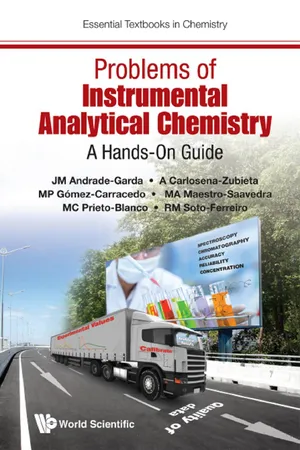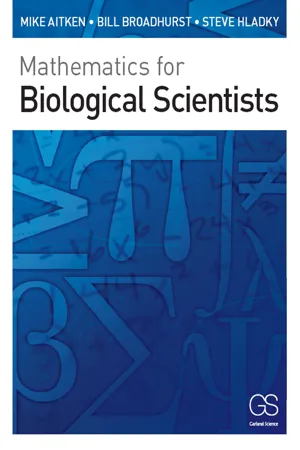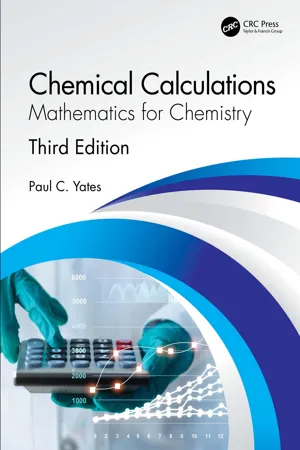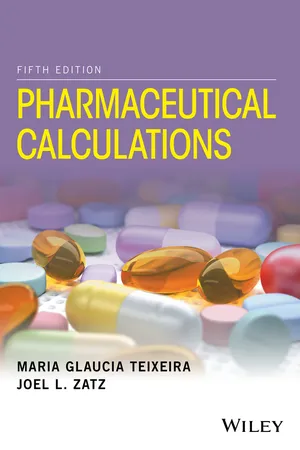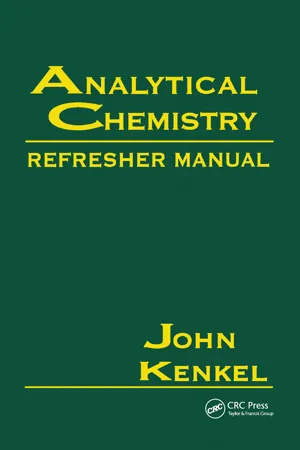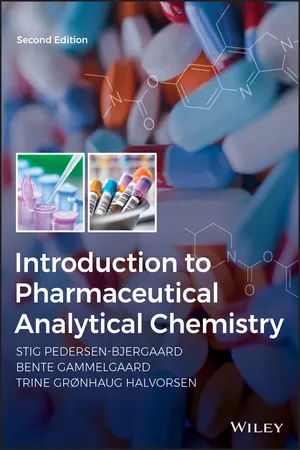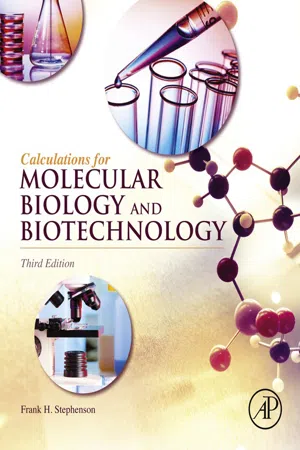Chemistry
Concentration
Concentration refers to the amount of a substance present in a given volume of a solution. It is typically expressed as the mass of the solute per unit volume of the solvent. Concentration is an important factor in chemical reactions and plays a crucial role in determining the properties and behavior of a solution.
Written by Perlego with AI-assistance
Related key terms
Related key terms
1 of 4
Related key terms
1 of 3
9 Key excerpts on "Concentration"
- eBook - ePub
Problems of Instrumental Analytical Chemistry
A Hands-On Guide
- JM Andrade-Garda, A Carlosena-Zubieta;MP Gómez-Carracedo;MA Maestro-Saavedra;MC Prieto-BlancoRM Soto-Ferreiro(Authors)
- 2017(Publication Date)
- WSPC (EUROPE)(Publisher)
According to IUPAC, the term Concentration includes four quantities characterizing the composition of a mixture with respect to the volume of the mixture [ 4 ]: mass, amount, volume and number Concentration. Also, the term Concentration is a shortcut for amount-of-substance Concentration or amount Concentration. The SI unit for the amount of substance is the mole (n): defined as the amount of substance of a system which contains as many elementary entities as there are atoms in 0.012 kilogram of carbon- 12 [ 2 ]. IUPAC recommends that this physical quantity (’amount of substance’) is no longer called ‘number of moles’, just as the physical quantity ‘mass’ should not be called ‘number of kilograms’. This unit is selected so that the atomic mass (expressedinthe unified atomic mass unit, u) and the molar mass (in grams/mol) have the same numerical value (Note: the abbreviation amu is not an acceptable unit symbol nowadays for the unified atomic mass unit). In general, the calculations that involve moles of a substance require the use of the molar mass of that substance. The terms atomic weight and molecular weight are obsolete and, thus, should be avoided. They have been replaced by the equivalent but preferred terms relative atomic mass and relative molecular mass, respectively, which are simple dimensionless numbers. When they are expressed as g/mol, they are designated as molar mass, represented by M, for both atoms and molecules. The Concentration or amount-of-substance Concentration (c A) is the amount of a substance, A, divided by the volume of the mixture in which it is present: c A = n A / V. The common unit is mol/dm 3 or mol/L. Molarity (M) is commonly used instead of these terms. Thus, the molarity for a 0.5 mol/dm 3 solution is said to be 0.5 M (0.5 molar solution). However, NIST’s Guide [ 3 ] prefers the original term because it is unambiguous; they recommend that the term molarity and the M symbol should no longer be used because they are obsolete - eBook - ePub
- Mike Aitken, Bill Broadhurst, Stephen Hladky(Authors)
- 2009(Publication Date)
- Garland Science(Publisher)
−1 are often referred to as molarities but more often just as ‘Concentrations’. Using molarity is convenient and relatively harmless, and all efforts by the ‘standardizers’ to stamp it out have so far failed. Perhaps someday this unit will follow the liter and be allowed in from the cold.Concentration in terms of the amount of solute is what we want whenever we are considering reactions or even just diffusion. Concentration in terms of (amount of solute)/(volume of solution), namely molarity, is just what we want whenever we want to use a pipette to deliver a known amount of solute.MolalityIn most laboratories, mass can be measured much more accurately than volume. Thus in the most careful work, it is very useful to refer Concentration not to the volume of the solution but rather to the mass of solvent. The reason for choosing mass of solvent rather than mass of solution is considered in the next section. The SI unit for Concentration, defined as amount of solute divided by the mass of solvent, is mol kg−1 . The obsolete name for this unit was molal, with symbol m. This unit and its symbol have largely disappeared from use, which is just as well because m is already overworked as meter and m as mass. However, Concentrations measured in mol kg−1 are still often referred to as molalities. A non-SI unit, mol (liter of cell water)−1 , has been used in cell physiology to mean essentially the same as mol kg−1 because to sufficient accuracy the mass of 11 of cell water is 1 kg. In this case the SI unit does exactly what is wanted and is easier to write so the non-SI unit should be abandoned.Molarity versus molalityIn a relatively dilute solution such as 0.15 M NaCl, the Concentration can be expressed as either 0.15 M or 0.15 mmol kg−1 because almost all of the solution is solvent and 1 l of solution will contain very close to 1 kg of solvent. If these numerical values are so similar, why bother with the distinction between molarity and molality? The answer is, of course, that they are not always close – molarity and molality differ if either some of the solutes in the solution are sufficiently large or - eBook - ePub
Chemical Calculations
Mathematics for Chemistry, Third Edition
- Paul C. Yates(Author)
- 2023(Publication Date)
- CRC Press(Publisher)
4 Solution ChemistryDOI: 10.4324/9781003299981-44.1 Introduction
In some respects, the physical chemistry of liquid solutions is more complicated than that of either gases or solids. Molecules in the gas phase have relatively large separations, so the interactions between them are reduced and many approximations may be used to simplify the maths involved. Conversely, if a solid is crystalline it can be considered to be composed of many repeats of a simple unit, which again reduces the complexity of the maths required.In this chapter, we will be concerned only with aqueous solutions, as these form by far the largest group of interest.4.2 Concentration of Solutions
4.2.1 Concentration of a Solution
The Concentration of a solution is calculated from the simple equationc =n Vwhere n is the amount of substance dissolved in volume V. In the laboratory we are more interested in determining the mass m of a substance that needs to be dissolved, and this is related to the amount by the equationn =m Mwhere m is the molar mass, typically given in units of g mol−1 . If we combine these equations we havec =which gives us the Concentration in terms of the mass dissolved.n V==m MVmM VWorked Example 4.1- What is the Concentration of the resulting solution when 25.0 g of sodium chloride is dissolved in 100 cm3 of water?
- What amount of sodium chloride is present in 300 cm3 of a solution of Concentration 0.25 mol dm−3 ?
CHEMICAL BACKGROUNDSodium chloride is very soluble in water because it is an ionic compound. Since there are two isotopes of chlorine, its atomic mass is a weighted value based on the abundance of each.Solution to Worked Example 4.1- The first step in this problem is to calculate the molar mass of NaCl, which is simply the sum of the atomic masses of sodium and chlorine. This is
M NaCl=M Na+M Cl=22.99g mol+ 35.45− 1g mol− 1=58.44g mol− 1We then need to consider the volume we have been given and convert this to units of dm3 to obtain a Concentration value in mol dm−3
- eBook - ePub
- Maria Glaucia Teixeira, Joel L. Zatz(Authors)
- 2017(Publication Date)
- Wiley(Publisher)
not solvent). We may define Concentration thus:6.2. Percentage Strength Expressions
If the solute and the preparation are expressed in the same units, the Concentration is dimensionless. It indicates the portion of the preparation represented by solute, and is written as a decimal or fraction. For example, if 10 mL of alcohol were dissolved in a sufficient quantity of water to make 40 mL of solution, the Concentration of alcohol would bePercent Concentration is defined as the number of parts of solute in 100 units of solution or mixture. Concentration expressed as a decimal may be converted to percent by multiplying by 100:6.2.1. Percent Volume-in-Volume
This alcohol Concentration described above may be written 25% by volume or 25% volume in volume or 25% v/v to indicate that both the solute (alcohol) and solution were liquids and measured by volume. In the example, alcohol is contributing with 25% (by volume) and water is contributing with 75% (by volume), although the exact amount of water is not known since alcohol contracts when diluted.Let us check some more examples of volume-in-volume Concentrations.- Ex. 1. If 12 mL of peppermint oil were dissolved in sufficient alcohol to make 80 mL of solution, what would be the Concentration of peppermint oil in this solution expressed as
- a decimal?
- a percent?
- Ex. 2. The formula for 1 L of syrup contains 0.5 mL of orange oil. What is the percentage strength (v/v) of the oil in the syrup?
Answers- Ex. 1.
- 0.15 v/v
- 15% v/v
- Ex. 2. 0.05% v/v
- Ex. 1.
- 0.15 v/v × 100 = 15% v/v
- Ex. 2.
6.2.2. Percent Weight-in-Weight
If the quantity of solute and that of the preparation are expressed in the same units of weight, the Concentration is dimensionless. If 10 g of charcoal are mixed with 40 g of lactose (another powder) to make a total of 50 g, the charcoal Concentration is - eBook - ePub
Environmental Process Analysis
Principles and Modeling
- Henry V. Mott(Author)
- 2013(Publication Date)
- Wiley(Publisher)
3Concentration Units for Gases, Liquids, and Solids
3.1 SELECTED Concentration UNITS
With the exception of pure substances for which volume, density, and mass have a unique relation depending upon the nature of pure substances, in order to express the quantity (abundance) of a substance present in a solution or in a volume of soil, for example, we need to have a parameter termed Concentration. Concentration is an analog of density. For a substance dissolved in a liquid, intimately mixed in a gas, or comingled with a solid or soil, the Concentration and density would be identical if we held volume constant and simply removed all components other than the constituent of interest. Engineers tend to express their Concentrations using mass units, scientists (here predominantly the chemists) tend to desire use of molar units, and various groups within each major area have their own pet sets of units used in their particular subdiscipline.In Table 3.1 , various units are listed and defined. These are divided into gas-phase, liquid-phase, and special categories. Further subdivisions are included for mass and molar units. Following the table, a number of examples of application/interconversion are presented.In Table 3.2 , several values of the universal gas constant (R ) are presented. The first six are of course the most useful and the remainder are included in case the reader might encounter a situation in which alternative units of measure are employed.TABLE 3.1 Commonly Used Units of ConcentrationUnit Description Gas phase units atmi Partial pressure of component i —the pressure exerted in a gas phase by the component of interest, component i - eBook - ePub
- John Kenkel(Author)
- 2020(Publication Date)
- CRC Press(Publisher)
If the solute is a liquid (somewhat rare), the grams calculated from Equation 3.10 can be converted to milliliters using the density of the liquid. In this way, the volume of the liquid can then be measured, rather than its weight, and it can then be pipetted into the container.Sometimes it may be necessary to prepare a solution of a certain molarity by diluting another solution, the Concentration of which is known in, for example, weight/volume percent. As noted earlier (Section 3.2 ), however, the dilution formula can only be applied when the two Concentrations have the same units. In this case, the weight/volume percent can be converted to molarity and the volume to be diluted calculated in the usual way.Example 8How would you prepare 500 mL of a 0.20 M solution of NaOH from an NaOH solution that is 10% (w/v)?Solution 840 mL of the 10% NaOH would be measured into a 500 mL container and diluted to volume.10 %(= 10 g / 0.10 Lw / v)= 100 g / LMolarity =100 40.00= 2.5 M2 .5 ×V B= 0.20 × 500V B= 40 mL3.5 NORMALITY
Another method of expressing solution Concentration is normality. Normality is the number of equivalents per liter. It is the typical Concentration unit when working within the system in which quantities of chemicals are expressed as equivalents and equivalent weights. This system is completely analogous to the system of moles and molecular weights. That means that in all calculations performed in which the mole and the molecular weight are used (including solution preparation), the equivalent and equivalent weight may also be used. Normality is the number of equivalents of solute dissolved per liter of solution, while molarity is the number of moles of solute dissolved per liter of solution.3.5.1 Concept of the Equivalent
To understand normality, we obviously must understand the concept of the equivalent. An equivalent is almost always either the same as the mole or it is some fraction of a mole, such as half a mole, a third of a mole, etc. What that fraction is depends on the reaction in which the substance takes part. The equivalent of a substance is that part of a mole which reacts on a one-to-one basis with another substance. If one mole of one substance reacts with one mole of another substance, it may be more convenient to work in terms of moles and molarity rather than equivalents and normality. If, however, one mole of one substance reacts with, say, two moles of another substance, then, if you want to work with normality, solution preparation schemes and associated calculations must involve the equivalent, rather than the mole, and the equivalent weight rather than the molecular weight. - eBook - ePub
Chemistry
With Inorganic Qualitative Analysis
- Therald Moeller(Author)
- 2012(Publication Date)
- Academic Press(Publisher)
14.18 ).A 1m solution of NaOH would be prepared by dissolving 40 g (1 mole) of NaOH in 1000 g of water, or 20 g (0.5 mole) of NaOH in 500 g of water, or any combination that maintains this proportion. The molality of a solution of any number of moles of solute B, n B , in any mass of solvent A, is found from the following relationship:(9)EXAMPLE 14.3
Find the molality of the sugar solution described in Example 14.2 .Substituting 70.00 g of solvent and 0.08764 mole of sucrose into Equation (9) for molality yieldsThe sugar solution is 1.252m .14.13 Preparation of solutions
It is often necessary in the laboratory to prepare solutions of a specific Concentration from solids or from solutions of other Concentrations. The facts needed to accomplish this are the weight or volume of solute and the weight or volume of solvent that must be combined.In making dilute solutions from more concentrated solutions, the amount of solute present in a given volume of the concentrated solution must be known. Solvent is then added to change the Concentration of the solution, but note that the amount of solute is unchanged.We remind you here of some relationships that are useful in solution and dilution problems.wThe simplest way to solve solution and dilution problems is to choose a “basis” from which to work the problem using the information given. For example, the basis might be 100 g of solution, or 1 kg of solution, or 100 g of solute. If the problem has several parts, the basis is used in solving each part. - Stig Pedersen-Bjergaard, Bente Gammelgaard, Trine G. Halvorsen(Authors)
- 2019(Publication Date)
- Wiley(Publisher)
Concentration. Concentration means the amount of solute per volume unit of solution. In this example the Concentration could be expressed in SI units (g/L) as 0.100 g/0.5 L = 0.200 g/L. Often Concentrations are expressed in milligram per millilitre (mg/mL) instead. Micrograms per millilitre (μg/mL), nanogram per millilitre (ng/mL), or picogram per millilitre (pg/mL) can also be used:(4.1)An example of how to convert from mg/mL to μg/mL is shown in Box 4.1 .Box 4.1 Conversion from mg/mL to μg/mL
The Concentration of paracetamol in a solution is 0.0125 mg/mL. This corresponds to the following Concentration in μg/mL:Often the term molarity is used to express the Concentration. One mol is Avogadro's number (NA = 6.022 × 1023 mol−1 ) of particles (atoms, molecules, ions). It is important to realize that mol is a number. The molarity of a certain solution is defined as follows:(4.2)The unit of molarity is mol/L = M. In Box 4.2 the molarity of paracetamol is calculated when 0.100 g of this substance is dissolved in 500.0 mL. In pharmaceutical analysis, molarity is often used to express Concentration of chemical reagents in solution, such as solutions of hydrochloric acid, sodium hydroxide, and potassium hydrogen phthalate used for titration.Box 4.2 Calculation of molarity
0.100 g of paracetamol (molar mass = 151.2 g/mol) is dissolved in water and the total volume is adjusted to 500.0 mL. The molarity of the solution with respect to paracetamol is calculated as- Frank H. Stephenson(Author)
- 2016(Publication Date)
- Academic Press(Publisher)
Chapter 2Solutions, Mixtures, and Media
Abstract
Whether it is an organism or an enzyme, most biological activities function at their optimum only within a narrow range of environmental conditions. From growing cells in culture to sequencing of a cloned DNA fragment or assaying an enzyme's activity, the success or failure of an experiment can hinge on paying careful attention to a reaction's components. This section outlines the mathematics involved in making solutions. This chapter covers how to make dilutions to new Concentrations of percent, molarity, factor of X, and normality. This chapter shows how to calculate pH and how the Henderson–Hasselbalch equation is used to prepare a buffer having a particular desired pH.Keywords
Acid; Acid dissociation constant; Addition property of equality; Base; Bronsted acid; Bronsted base; Conjugate acid; Conjugate base; Dilution; Dimensional analysis; Equilibrium; Formula weight; Gram molecular weight; Henderson–Hasselbalch equation; Molarity; Molecular weight; Multiplication property of equality; Normality; Percent; pHIntroduction
Whether it is an organism or an enzyme, most biological activities function at their optimum only within a narrow range of environmental conditions. From growing cells in culture to sequencing of a cloned DNA fragment or assaying an enzyme's activity, the success or failure of an experiment can hinge on paying careful attention to a reaction's components. This section outlines the mathematics involved in making solutions.2.1. Calculating Dilutions: A General Approach
Concentration is defined as an amount of some substance per a set volume:Concentration =amount volumeMost laboratories have found it convenient to prepare concentrated stock solutions of commonly used reagents, those found as components in a large variety of buffers or reaction mixes. Such stock solutions may include 1 M Tris, pH 8.0, 500 mM EDTA, 20% sodium dodecylsulfate (SDS), 1 M MgCl2 , and any number of others. A specific volume of a stock solution at a particular Concentration can be added to a buffer or a reagent mixture so that it contains that component at some Concentration less than that in the stock. For example, a stock solution of 95% ethanol can be used to prepare a solution of 70% ethanol. Since a higher percent solution (more concentrated) is being used to prepare a lower percent (less concentrated) solution, a dilution
Index pages curate the most relevant extracts from our library of academic textbooks. They’ve been created using an in-house natural language model (NLM), each adding context and meaning to key research topics.
Explore more topic indexes
Explore more topic indexes
1 of 6
Explore more topic indexes
1 of 4
